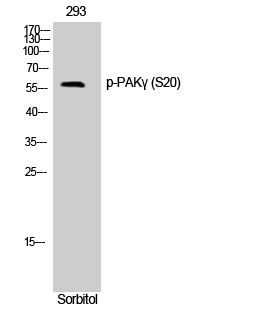Phospho PAK2 (S141) Cell-Based Colorimetric ELISA Kit
- Catalog No.:KA1715C
- Applications:ELISA
- Reactivity:Human;Mouse;Rat
- Gene Name:
- PAK2
- Human Gene Id:
- 5062
- Human Swiss Prot No:
- Q13177
- Mouse Swiss Prot No:
- Q8CIN4
- Rat Swiss Prot No:
- Q64303
- Storage Stability:
- 2-8°C/6 months
- Other Name:
- Serine/threonine-protein kinase PAK 2 (EC 2.7.11.1) (Gamma-PAK) (PAK65) (S6/H4 kinase) (p21-activated kinase 2) (PAK-2) (p58) [Cleaved into: PAK-2p27 (p27);PAK-2p34 (p34) (C-t-PAK2)]
- Detection Method:
- Colorimetric
- Background:
- catalytic activity:ATP + a protein = ADP + a phosphoprotein.,enzyme regulation:Activated by binding small G proteins. Binding of GTP-bound CDC42 or RAC1 to the autoregulatory region releases monomers from the autoinhibited dimer, enables phosphorylation of Thr-402 and allows the kinase domain to adopt an active structure (By similarity). Following caspase cleavage, autophosphorylted PAK-2p34 is constitutively active.,function:The activated kinase acts on a variety of targets. Phosphorylates ribosomal protein S6, histone H4 and myelin basic protein. Full length PAK 2 stimulates cell survival and cell growth. The process is, at least in part, mediated by phosphorylation and inhibition of pro-apoptotic BAD. Caspase-activated PAK-2p34 is involved in cell death response, probably involving the JNK signaling pathway. Cleaved PAK-2p34 seems to have a higher activity than the CDC42-activated form.,PTM:During apoptosis proteolytically cleaved by caspase-3 or caspase-3-like proteases to yield active PAK-2p34.,PTM:Full length PAK 2 is autophosphorylated when activated by CDC42/p21. Following cleavage, both peptides, PAK-2p27 and PAK-2p34, become highly autophosphorylated, with PAK-2p27 being phosphorylated on serine and PAK-2p34 on threonine residues, respectively. Autophosphorylation of PAK-2p27 can occur in the absence of any effectors and is dependent on phosphorylation of Thr-402, because PAK-2p27 is acting as an exogenous substrate.,PTM:PAK-2p34 is myristoylated.,PTM:Ubiquitinated, leading to its proteosomal degradation.,similarity:Belongs to the protein kinase superfamily.,similarity:Belongs to the protein kinase superfamily. STE Ser/Thr protein kinase family. STE20 subfamily.,similarity:Contains 1 CRIB domain.,similarity:Contains 1 protein kinase domain.,subcellular location:Interaction with ARHGAP10 probably changes PAK-2p34 location to cytoplasmic perinuclear region. Myristoylation changes PAK-2p34 location to the membrane.,subunit:Interacts tightly with GTP-bound but not GDP-bound CDC42/p21 and RAC1. Interacts with SH3MD4. Interacts with and activated by HIV-1 Nef. PAK-2p34 interacts with ARHGAP10.,tissue specificity:Ubiquitously expressed. Higher levels seen in skeletal muscle, ovary, thymus and spleen.,
- Function:
- protein complex assembly, protein amino acid phosphorylation, negative regulation of protein kinase activity,phosphorus metabolic process, phosphate metabolic process, apoptosis, cytoskeleton organization, actin filament organization, actin polymerization or depolymerization, cell death, programmed cell death, death, phosphorylation,regulation of phosphate metabolic process, actin filament-based process, actin cytoskeleton organization, negative regulation of kinase activity, cellular macromolecular complex subunit organization, regulation of growth, regulation of phosphorylation, negative regulation of catalytic activity, regulation of kinase activity, macromolecular complex subunit organization, negative regulation of molecular function, regulation of protein kinase activity, protein amino acid autophosphorylation, regulation of phosphorus metabolic process, regulation of transferase a
- Subcellular Location:
- [Serine/threonine-protein kinase PAK 2]: Cytoplasm. MYO18A mediates the cellular distribution of the PAK2-ARHGEF7-GIT1 complex to the inner surface of the cell membrane.; [PAK-2p34]: Nucleus. Cytoplasm, perinuclear region. Membrane; Lipid-anchor. Interaction with ARHGAP10 probably changes PAK-2p34 location to cytoplasmic perinuclear region. Myristoylation changes PAK-2p34 location to the membrane.
- Expression:
- Ubiquitously expressed. Higher levels seen in skeletal muscle, ovary, thymus and spleen.
- June 19-2018
- WESTERN IMMUNOBLOTTING PROTOCOL
- June 19-2018
- IMMUNOHISTOCHEMISTRY-PARAFFIN PROTOCOL
- June 19-2018
- IMMUNOFLUORESCENCE PROTOCOL
- September 08-2020
- FLOW-CYTOMEYRT-PROTOCOL
- May 20-2022
- Cell-Based ELISA│解您多样本WB检测之困扰
- July 13-2018
- CELL-BASED-ELISA-PROTOCOL-FOR-ACETYL-PROTEIN
- July 13-2018
- CELL-BASED-ELISA-PROTOCOL-FOR-PHOSPHO-PROTEIN
- July 13-2018
- Antibody-FAQs



